Your bedroom isn’t just a spot to crash at night. It’s your own sanctuary—a place to unwind, escape, and recharge after everything life throws at you.
Remember to repin your favorite images!
When you set out to create a master bedroom retreat, you get to design a space that really fits your needs and shows off your personality.
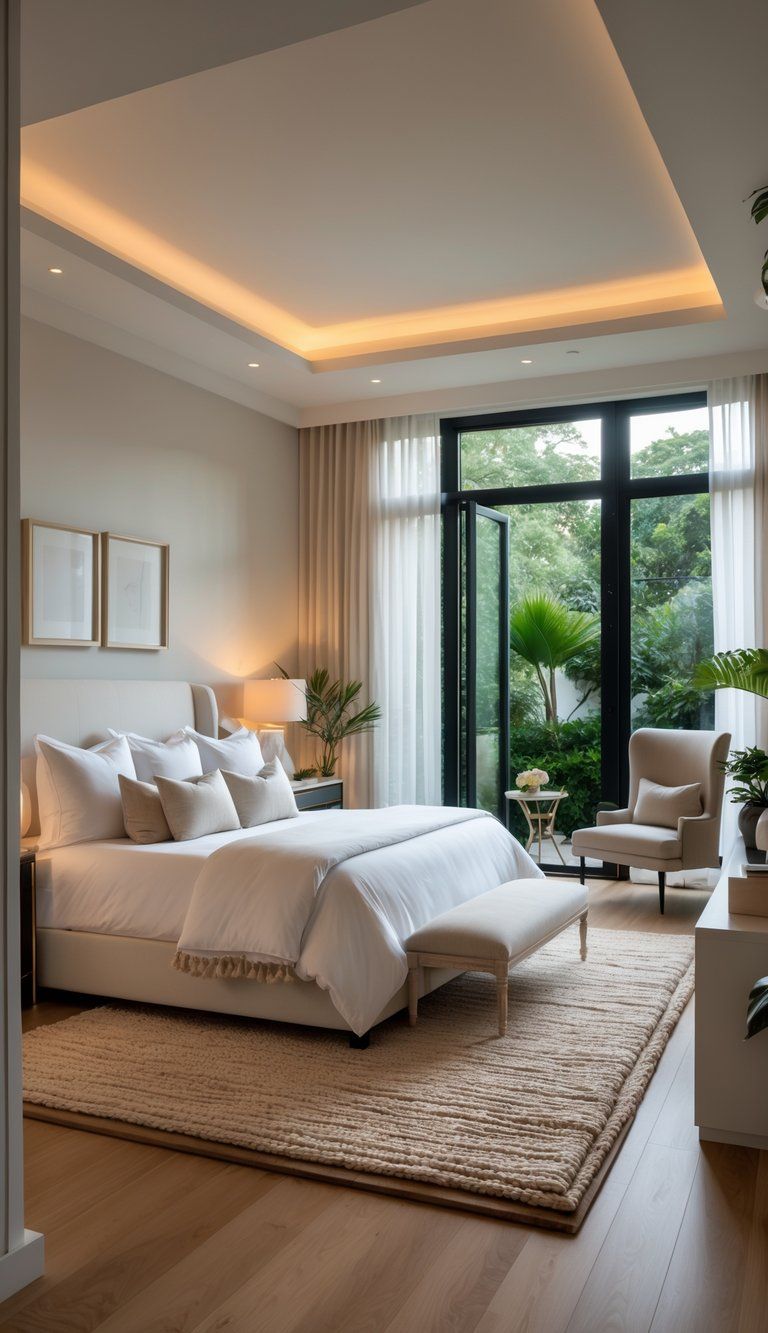
A great master bedroom mixes style and function, so you can actually relax and feel at peace there. Soft textures, calming colors, and smart furniture placement help the room flow naturally.
Maybe your retreat has plush bedding, cozy lighting, or even a dreamy spa-style bathroom attached.
You don’t need to spend a fortune to feel pampered. Some of the most relaxing bedrooms keep things simple and calm.
Try warm neutrals, bring in natural materials, and get rid of clutter—suddenly, your bedroom feels like the retreat you’ve always wanted, and you didn’t even have to splurge. The goal? A space that feels both a little indulgent and totally comfortable.
Defining Your Master Bedroom Retreat
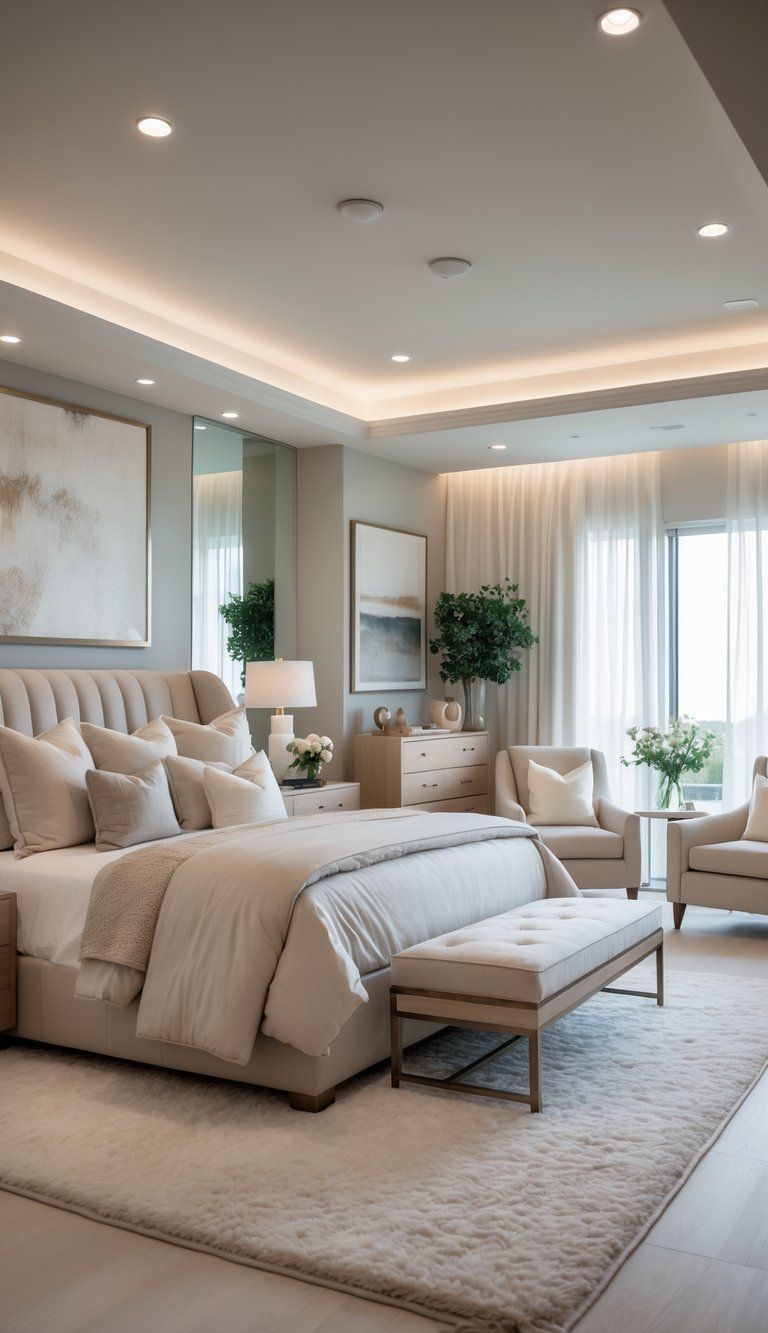
A master bedroom retreat isn’t just a sleeping spot. It’s a personal sanctuary that shows off your style and gives you a break from daily stress.
What Makes a Bedroom a Sanctuary
A bedroom sanctuary lets you escape. Unlike a basic bedroom, a retreat offers comfort for both your body and mind.
When you walk in, your stress should drop. Thoughtful design choices can set the right mood and engage your senses in a positive way.
Privacy matters here. Make your retreat feel set apart from the rest of your home. If noise is an issue, think about how sound moves and add barriers or soft furnishings.
Add personal touches to turn a generic room into your own sanctuary. Fill it with things that spark joy or good memories.
Control the temperature and lighting to set the right mood. Dimmers, blackout curtains, and a good heating or cooling setup make a big difference.
Key Elements of a Perfect Retreat
Quality bedding is the starting point for any bedroom retreat. Go for:
- Soft, high thread-count sheets
- A mattress that actually supports you
- Pillows that suit how you sleep
- Layered bedding so you can adjust for temperature
Decluttered space is essential for relaxation. Hide what you don’t need to see, but keep things you use close at hand.
Soft textures make the room feel cozy. Try mixing:
- Plush rugs
- Velvet pillows
- Chunky knit blankets
- Upholstered headboards
Good lighting sets the mood. You’ll want a mix: task lighting for reading, ambient lighting for atmosphere, and as much natural light as you can get.
Set up a quiet corner for yourself. Even a comfy chair in a small nook can become a spot for meditation, reading, or just zoning out.
Embracing Comfort and Relaxation
Color really affects how relaxing your room feels. Soft neutrals, blues, and greens can make things feel calm.
Try adding things that appeal to your senses. Maybe an essential oil diffuser, some soft music, or even nature sounds.
Let technology help you relax. Smart features for lighting, temperature, or window shades can make your retreat feel extra luxurious.
Plants bring life and fresh air into your space. If you’re not a plant person, pick easy-care varieties.
Your routines matter too. Try to make your retreat support healthy habits—like reading before bed instead of scrolling on your phone.
Comfort is personal. What works for you might not be what you see in magazines. Trust your own preferences when you set up your sanctuary.
Choosing the Ideal Layout for Your Sanctuary
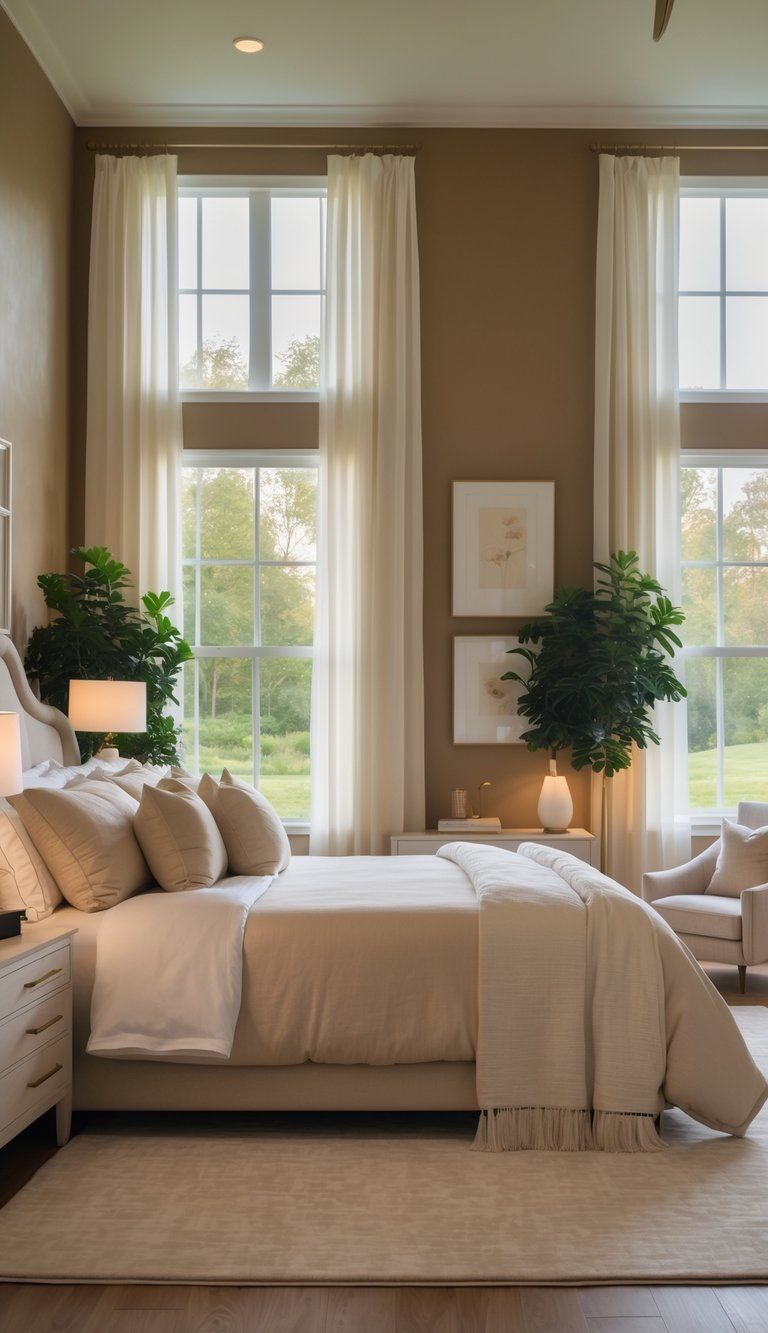
The way you arrange your master bedroom sets the mood for your retreat. A smart layout balances comfort and function, so you really feel at home.
Maximizing Space and Flow
Put your bed where you can see the door, but not right in line with it. This gives you a sense of security and helps the room’s energy flow. Leave a couple of feet around the bed so you can move easily.
If your room’s on the smaller side, try a platform bed with storage underneath. Wall-mounted nightstands save space but still give you a spot for essentials.
Keep natural pathways clear. Don’t block doors or closets with furniture—make sure you don’t have to awkwardly squeeze around anything.
Think about where your windows are for light and air. Place your bed to enjoy the view, but avoid direct sun in the morning if you like to sleep in.
Creating Distinct Zones
Divide your bedroom into different zones. Your sleeping area should be the main focus, with your bed and nightstands in the calmest spot.
Make a dressing zone near your closet or wardrobe. Add a full-length mirror and maybe a bench or stool. Good lighting helps here—use both natural light and some well-placed lamps.
If you have space, add a small work or hobby zone. A desk in the corner can double as a vanity or a spot for writing. Keep it tidy, so it doesn’t bring stress into your retreat.
Plan your storage carefully. Use built-ins, under-bed drawers, or shelves to keep things easy to reach but out of sight.
Incorporating a Sitting Area or Reading Nook
A sitting area turns your bedroom into more than just a sleeping spot. If you have the space, put a comfy armchair or chaise lounge away from the bed to create a separate chill-out zone.
A cozy reading nook needs three things: a comfy seat, good lighting, and a place for your books. Set it near a window for daylight, and add a lamp for nighttime reading.
Pick furniture that fits your space. An oversized chair works in a big room, but a slim chair or window seat is perfect for smaller spots. Add a little table for your coffee or tea.
Make your sitting area feel like its own space, but still part of the room. You can use an area rug or angle the furniture a bit to set it apart without breaking up the flow.
Selecting a Color Scheme for Tranquility
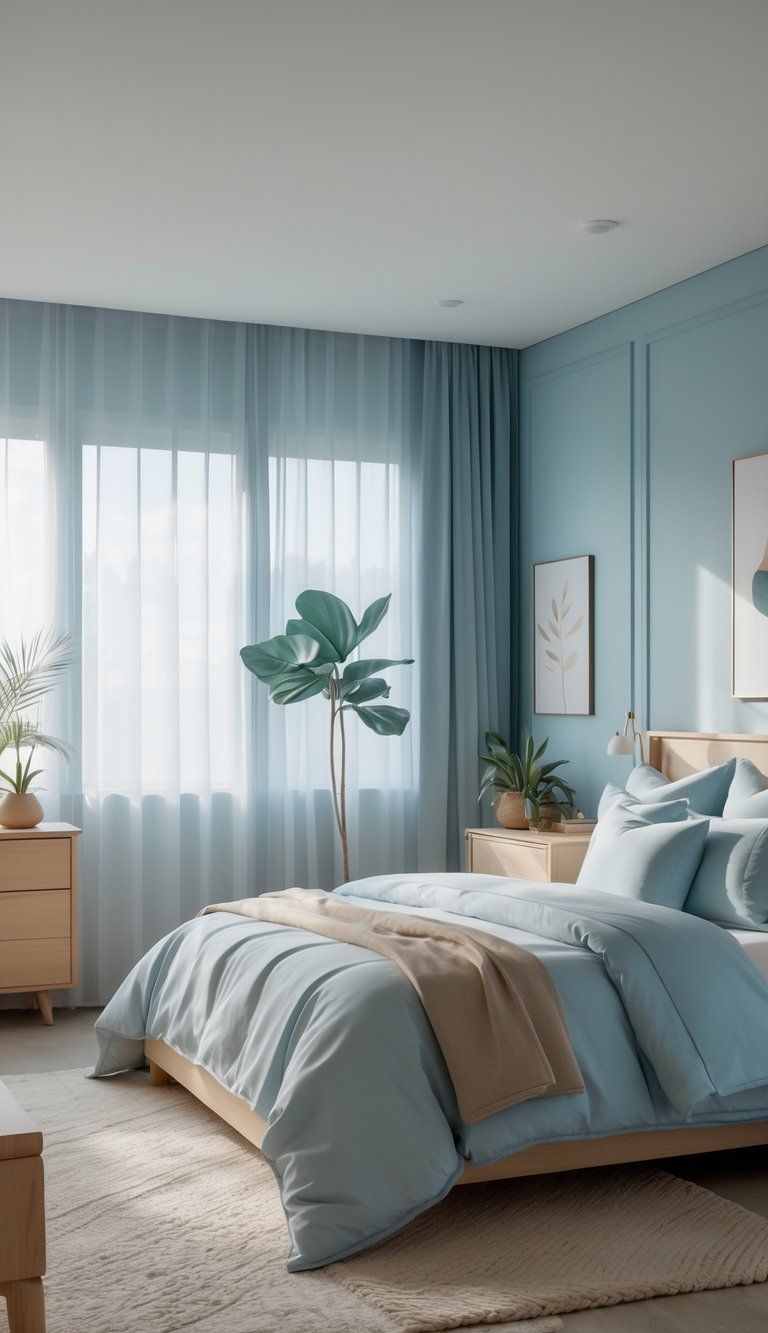
Your bedroom’s colors set the tone for relaxation. The right palette can help you unwind, sleep better, and turn your space into a real sanctuary.
Neutral and Soothing Tones
Neutrals make a perfect backdrop for a peaceful bedroom. Soft whites, warm beiges, and gentle grays bring a sense of calm and make your room feel bigger.
Some great neutral picks:
- Warm whites: Creamy, not too bright
- Soft grays: Think dove or pewter
- Gentle taupes: Earthy and grounding
Layering different shades of the same color adds depth without making things busy. This keeps the vibe chill while still looking interesting.
Pair neutral walls with natural materials like linen, cotton, or wood. These combos tell your brain it’s time to relax.
Pops of Color and Accent Choices
Even in a calm space, a little color keeps things from feeling bland. Just be selective with your accents.
Muted tones work best:
- Dusty blue pillows
- Sage green throws
- Soft lavender touches
Stick to two or three accent colors. Too many can make the room feel busy and less relaxing.
Pull accent colors from art or textiles you already love. This ties everything together naturally. Try adding color with lampshades, a favorite chair, or small décor pieces.
Nature-Inspired Palettes
Nature has the best color ideas for a tranquil bedroom. These palettes just feel soothing—they connect you to the outdoors.
Soft blues remind you of the sky or ocean and can actually help you relax and sleep better. Try pairing sky blue with white trim for a light, airy feel.
Greens like sage or moss bring the calm of plants inside. These shades look great on walls or in big pieces like your duvet or rug.
If you want something deeper but still peaceful, try:
- Forest green
- Ocean blue
- Mountain gray
These richer colors make your room feel cozy and protected, without losing that chill vibe.
Master Bedroom Design Styles
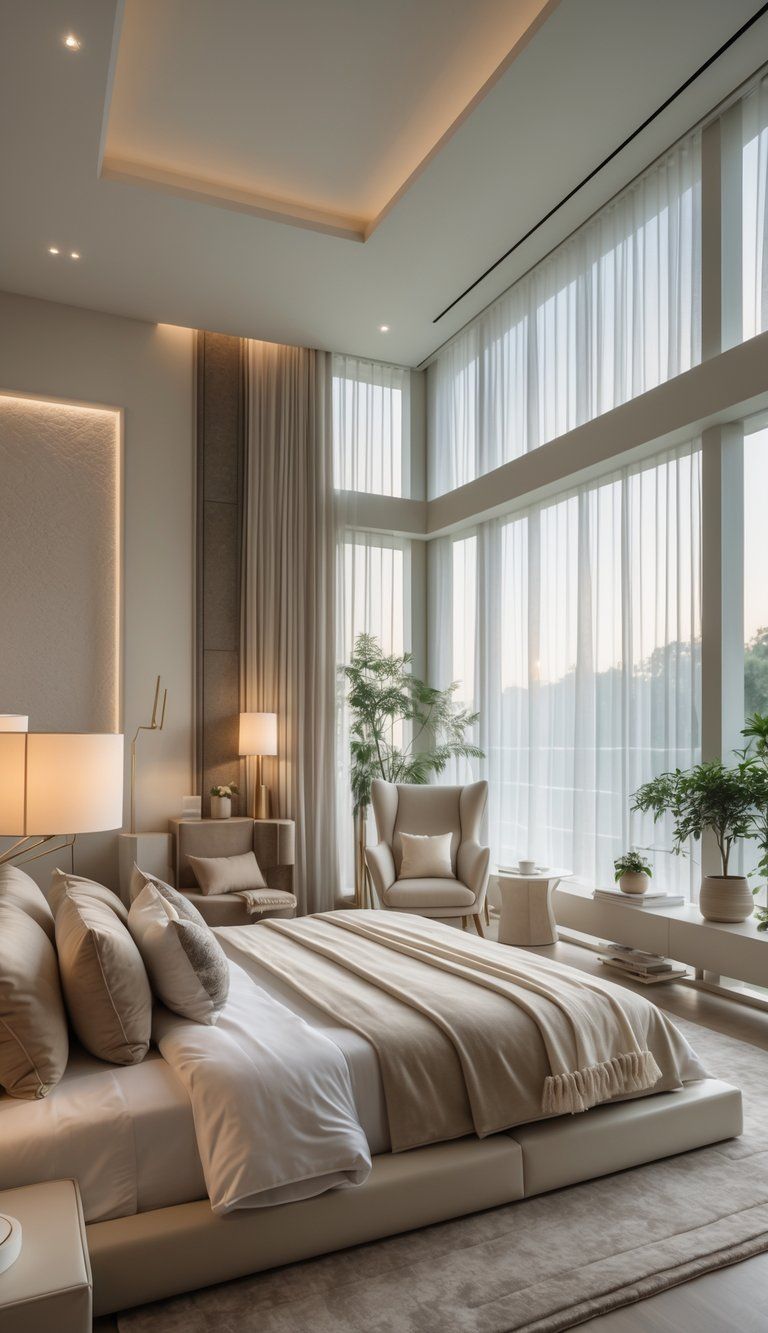
Picking a design style for your master bedroom can totally change the feel of the space. Each style gives you a different way to show your personality and make your bedroom a true retreat.
Minimalist Approach
Minimalist bedrooms stick to the idea that less really is more. Clean lines, simple colors, and clutter-free surfaces help create a calm atmosphere.
Choose a neutral palette—whites, grays, earth tones—to keep things feeling open and serene.
Minimalist must-haves:
- Simple, functional furniture with hidden storage
- Just a few special decorative pieces
- High-quality bedding in solids
- Clear nightstands and dressers
Lighting matters a lot here. Go for simple fixtures with soft, even light. Let in as much natural light as you can—keep window treatments straightforward.
When you limit color, texture becomes more important. Mix smooth surfaces with cozy textiles for interest without clutter.
Contemporary Master Bedroom
Contemporary style mixes comfort and sophistication with up-to-date materials and smart layouts. It nods to trends without going overboard.
Contemporary bedroom features:
- Bold accent colors on a neutral base
- A mix of textures—glass, metal, wood
- Statement lighting
- Smart home features for convenience
Let your bed be the star. A platform bed or one with a unique headboard can anchor the space.
Art matters in contemporary rooms. Pick one big piece or a curated gallery wall to show off your taste.
Balance is key. For every bold piece, add something calming. Maybe a modern reading chair or a simple bench at the end of your bed.
Rustic Charm and Natural Materials
Rustic style brings the outdoors inside with natural materials and earthy touches. This look is all about coziness and authenticity.
Bring in natural elements like:
- Exposed wood beams or paneling
- Stone details—on walls or as décor
- Textiles made from cotton, linen, or wool
- Leather chairs or accents
Rustic bedrooms usually stick to nature-inspired colors—warm browns, greens, and soft blues. These shades make the room feel connected to the outdoors.
Furniture with history fits perfectly. Antique or reclaimed wood pieces add character and tell a story.
Layering textiles makes things extra cozy. Use different textures in your bedding, add a plush rug, and toss in a few throw pillows for a complete rustic retreat.
Furnishing for Comfort and Luxury
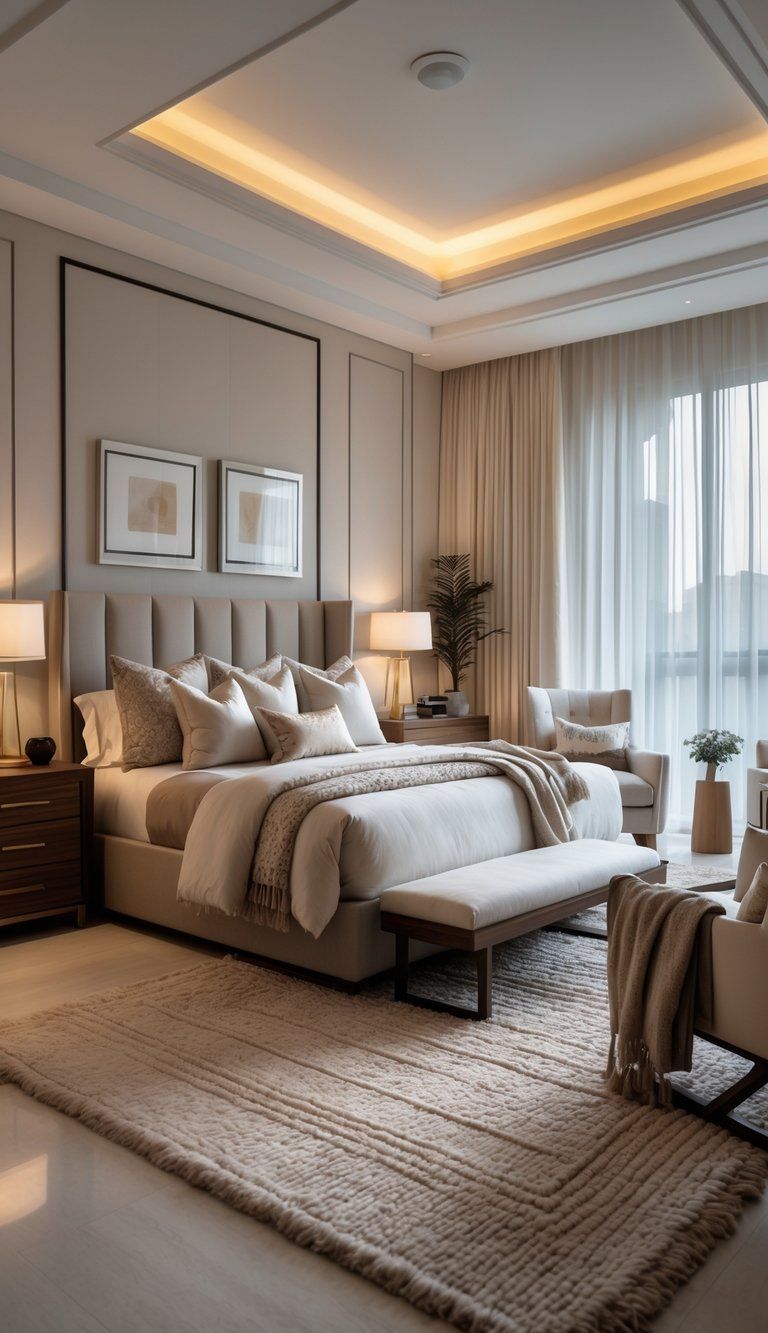
The right furniture sets the stage for any master bedroom retreat. Pick pieces that balance comfort and a touch of luxury, so you have a place to really relax and recharge after a long day.
Choosing the Right Bedroom Furniture
When you’re picking out bedroom furniture, aim for pieces that balance function and style. A quality bed frame really anchors your space, and nightstands offer practical storage and a spot for your favorite book or lamp.
Look for:
- Solid wood construction—it just lasts longer and never really goes out of style
- Cohesive finishes to keep things looking pulled together
- Proper scaling so your furniture actually fits the room
Dressers and armoires need to give you plenty of storage without ruining the vibe. Custom built-ins can make the most of your space and add a touch of luxury.
Try not to cram in too much furniture. A few well-chosen, quality pieces make a bigger impact than a room stuffed with extras.
Statement Headboards and Canopy Beds
A bold headboard or a dramatic canopy bed can totally change the feel of your bedroom. These pieces catch the eye and set the mood for the whole space.
Popular headboard options:
- Tufted fabric for a soft look and a bit of sound absorption
- Carved wood if you like a more classic, traditional vibe
- Metal frames for a sleek, modern feel
- Wall-mounted panels that stretch wider than the bed itself
Canopy beds add drama and a sense of coziness. Modern ones go from simple four-posters to fully draped hideaways. Those vertical lines? They’ll draw your eye up and make the ceiling seem taller.
When you’re choosing a statement bed, think about your ceiling height and the size of the room. You want the bed to stand out, but not take over.
Accent Pieces: Chaise Lounges and Seating
Adding a seating area makes your bedroom feel like a real retreat, not just a place to sleep. Comfy seating invites you to stay a while, read, or just take a breather.
A plush chaise lounge is perfect for curling up with a book or sipping your morning coffee. Try putting it near a window for sunlight, or tuck it in a cozy corner with a lamp.
If you’ve got space to play with, maybe add:
- A small loveseat or a couple of armchairs
- An upholstered bench at the foot of the bed
- A comfy vanity chair if you have the room
Make sure your seating matches your bed’s style and actually feels good to sit on. Fabrics like velvet or linen add texture and a little luxury.
Layering Lighting for Ambience
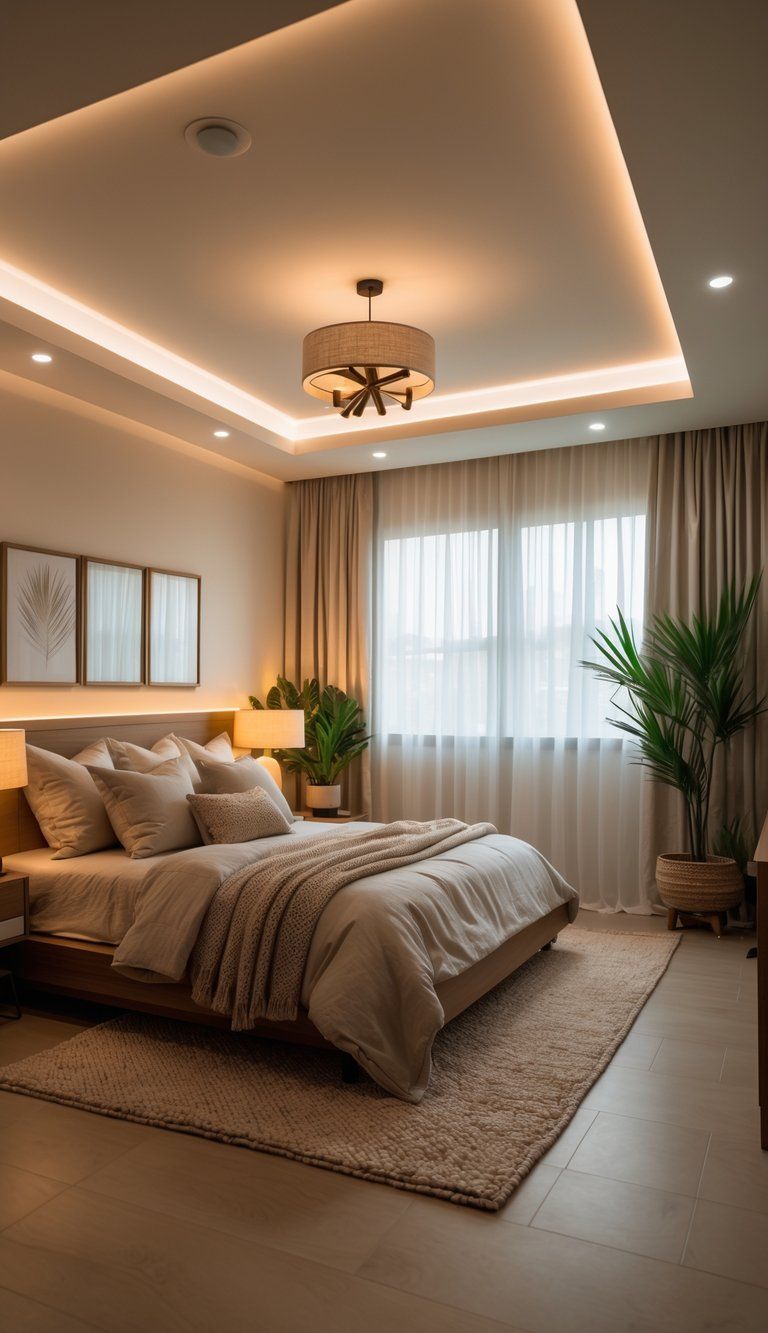
Lighting can completely change the mood in your master bedroom. Mixing different light sources lets you adjust the atmosphere depending on what you’re doing.
Ambient and Task Lighting Options
Start with ambient lighting. Recessed lights give you even coverage and keep things looking clean—no bulky fixtures in the way. Place them around your ceiling’s edge for the best effect.
For task lighting, grab some adjustable bedside lamps so you can shine light right where you want it. Wall-mounted sconces are great if you want to save space on your nightstand and still have focused reading light.
A ceiling fan with built-in lights pulls double duty, moving air and lighting up the room. Pick one with separate controls for the fan and light—makes life easier.
Pro tip: Put wall switches by the bed so you don’t have to get up to turn off the lights.
Statement and Pendant Lighting
Statement lighting brings personality and style. A chandelier in the center of the room instantly adds a touch of luxury and becomes a focal point. For sizing, add your room’s length and width in feet, then use that number in inches for the diameter.
Pendant lights give you flexibility. Hang them on either side of the bed instead of lamps, or cluster a few in a corner for an artsy vibe.
When you pick statement lighting, think about:
- Ceiling height (taller ceilings can handle bigger fixtures)
- Your room’s colors
- How much light the fixture actually puts out
Go bold if you want—lighting is a fun way to show off your personality.
Automated and Adjustable Lighting
Tech makes bedroom lighting so much easier these days. Dimmer switches let you control the brightness—crank it up in the morning or go soft at night.
Smart lighting systems take things up a notch. Use voice commands or your phone to set scenes: maybe a “morning” mode that gets brighter slowly, a “reading” mode that spotlights your book, or a gentle “nighttime” setting to wind down.
Motion-activated lights under the bed light your way for late-night trips without waking anyone. They’ll turn off on their own after a bit.
Try bulbs that let you adjust color temperature—cooler light for mornings, warmer light for evenings. It really does help with sleep.
Incorporating Textures and Materials
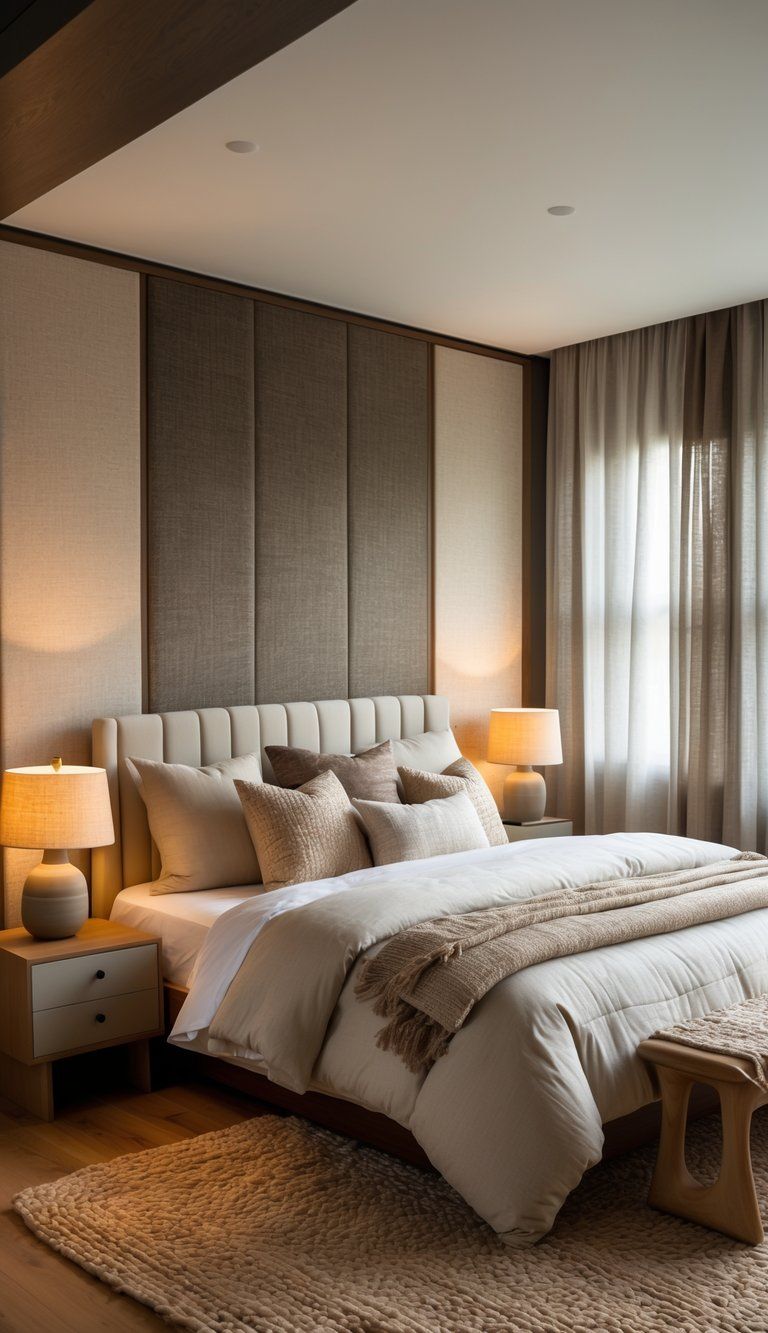
Mixing up textures and materials adds depth and coziness to your bedroom. Soft fabrics, plush accents, and natural materials all work together to make the space feel inviting.
Using Luxurious Fabrics for Cozy Appeal
Luxurious fabrics instantly make your bedroom more comfortable and appealing. Go for high-thread-count cotton sheets (400 or higher) if you love that silky feel. For colder nights, flannel or jersey sheets keep things warm without being heavy.
Layer your bed with different textures—maybe a quilted comforter, some velvet throw pillows, and a cashmere blanket. It looks great and feels even better.
Silk or satin pillowcases? They’re not just fancy—they help keep your skin smooth and your hair from getting tangled. For curtains, heavyweight linen filters light beautifully and adds texture to your walls.
Adding Soft Textures for Depth
Soft textures make the room feel finished and extra welcoming. Try these ideas:
- Throw blankets: Toss a chunky knit or faux fur throw at the foot of your bed
- Accent pillows: Mix up sizes and fabrics—velvet, linen, textured weaves
- Upholstered headboard: A tufted headboard really softens the whole look
- Wall coverings: Textured wallpaper or fabric wall panels help with sound and add warmth
Don’t forget about the ceiling. A little grasscloth wallpaper or a soft paint color can make things feel cozier.
Spread textures around—plush rugs under your feet, soft linens on the bed, textured lampshades that give off a warm glow.
Natural Elements and Large Area Rugs
Natural materials ground your space and bring in a timeless, authentic feel. Wood furniture with visible grain feels warm, while stone accents like marble lamps or agate bookends add a bit of variety.
A big area rug pulls your bedroom together and feels great to walk on. Pick natural fibers like wool, jute, or sisal—they’re durable and have great texture. Make sure the rug is big enough to go 18–24 inches past the sides of your bed.
Try adding:
- Rattan or wicker pieces
- Plants in textured pots
- Wooden wall art or sculptures
- Natural stone trays or coasters
Mix smooth and rough textures for contrast. A polished wood nightstand looks awesome next to a chunky linen duvet, and sleek metal lamps pair well with textured shades.
Organizing and Functional Storage Solutions
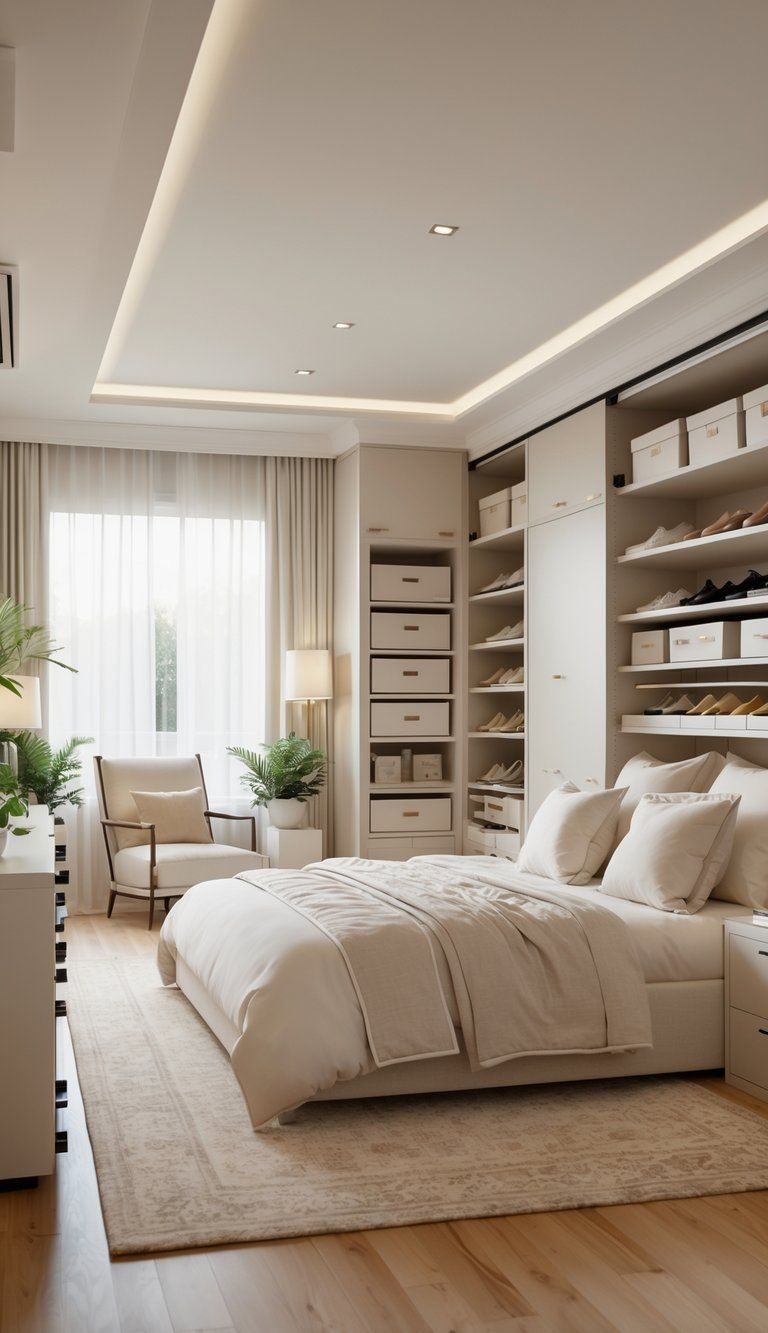
A tidy master bedroom feels so much more relaxing. Smart storage keeps clutter at bay while still looking stylish.
Efficient Closet Organization
Walk-in closets can be amazing if you set them up right. Sort your clothes by type and season to start. Install double hanging rods—shirts up top, pants below.
Try these must-haves:
- Custom shelves for folded clothes and accessories
- Pull-out drawers for socks and underwear
- Shoe racks or cubbies at eye level for easy grabbing
- Belt and tie racks on the wall or cabinet doors
Clear bins are great for off-season stuff. Label everything and use matching hangers for a neat look. If you’ve got the space, a small island or peninsula with drawers adds extra storage.
Dual-Purpose Furniture
Furniture that does double duty is a game changer. A storage ottoman at the foot of your bed offers a place to sit and hides extra blankets or pillows.
Platform beds with drawers underneath cut down on the need for bulky dressers. Look for:
- Side drawers for smaller things
- Bigger pull-out drawers at the foot
- Hydraulic lifts to stash things under the mattress
Wall-mounted nightstands free up floor space and still give you storage. Floating shelves above the bed let you display things without crowding the room. Some headboards even hide compartments for books or electronics.
Accessorizing Bedside Tables
Your bedside table should be both useful and stylish. Keep what you need close, but don’t let it get messy.
Try organizing with:
- A small tray for jewelry or glasses
- Drawer dividers for meds, hand creams, or chargers
- A pretty box for private stuff
- A lamp that fits without taking over
Put the things you use most right where you can reach them. Pick accessories that match your table’s size—no need to go overboard. Wireless charging pads keep cords out of sight and your devices charged.
Wall sconces give you more space for books or a plant. Fresh flowers or a little greenery can liven up the area.
Personalizing Your Master Bedroom Retreat
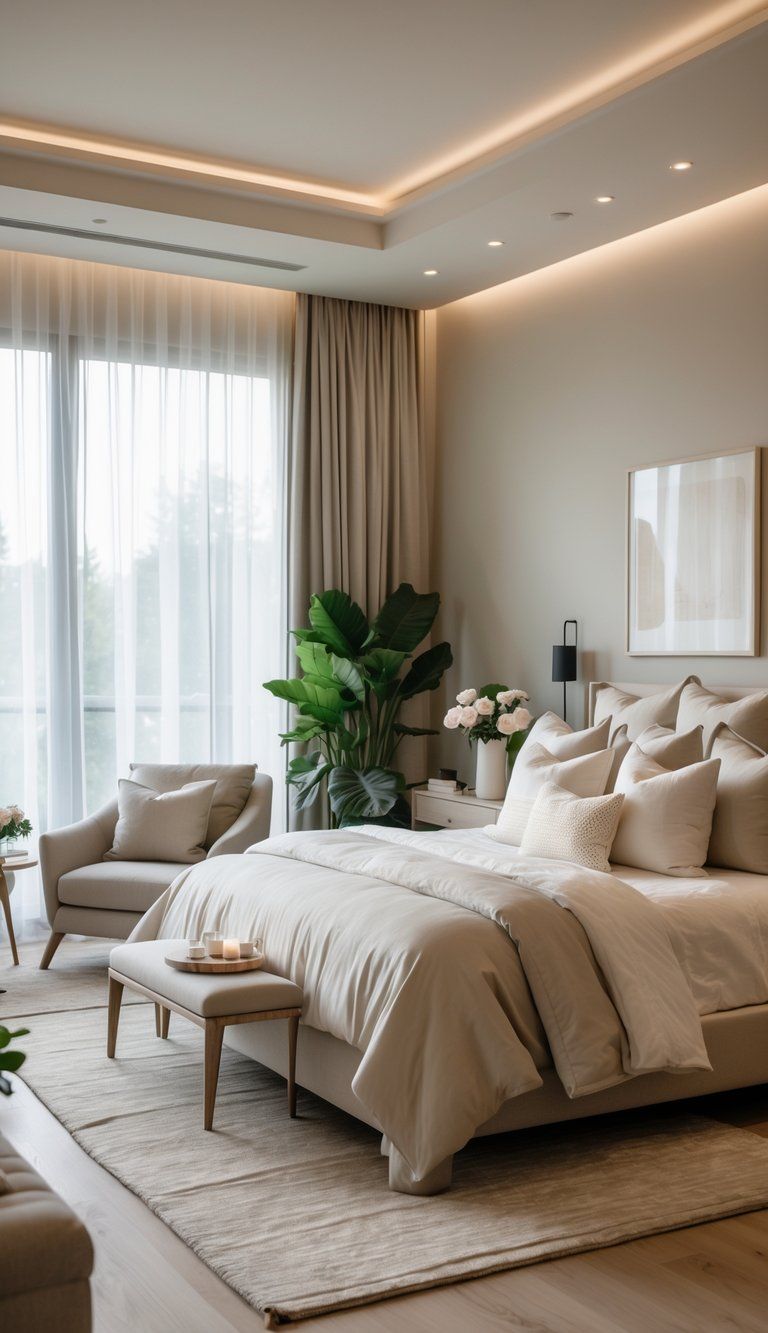
Your bedroom should feel like it’s truly yours. Personal touches turn a plain space into a real retreat.
Infusing Personal Touches
The best bedrooms tell your story. Display family photos in matching frames on your dresser or nightstand to keep things looking cohesive and surround yourself with good memories.
Travel souvenirs add character and spark conversation. That pottery from Mexico or a carved box from Thailand brings back happy times.
Books you love can double as decor. Stack a few on your nightstand or float some shelves to show off your favorites.
Add textiles that mean something—maybe a quilt from a family member or a pillow in your favorite print. These details make your space cozy and unique.
Decorative Mirrors and Artwork
Mirrors can do wonders. Put a large one across from a window to bounce natural light around and make the room feel bigger.
Pick mirrors with frames that fit your style:
- Vintage gold frames for a classic vibe
- Frameless for a modern look
- Sunburst designs if you want something dramatic
Choose artwork that makes you happy or fits your color scheme. Abstract art adds sophistication, while nature prints keep things calm.
Don’t crowd your walls. One big piece often looks better than a bunch of small ones. Hang art at eye level for the best effect.
Adding Indoor Plants for Freshness
Plants bring life, color, and even cleaner air to your bedroom. If you’re not a plant expert, try easy ones like snake plants or pothos.
A medium plant like a bird of paradise or rubber plant fills an empty corner nicely. Smaller plants look great on nightstands or dressers.
Some good beginner options:
- Peace lily (filters air, does well in low light)
- Lavender (soothing scent, helps you relax)
- Aloe vera (cleans the air and is handy for little cuts)
Pick pots that match your style and colors. Place plants where they’ll get the light they need—most bedroom-friendly types are fine with indirect light.
Creating a Spa-Like Bathroom Oasis
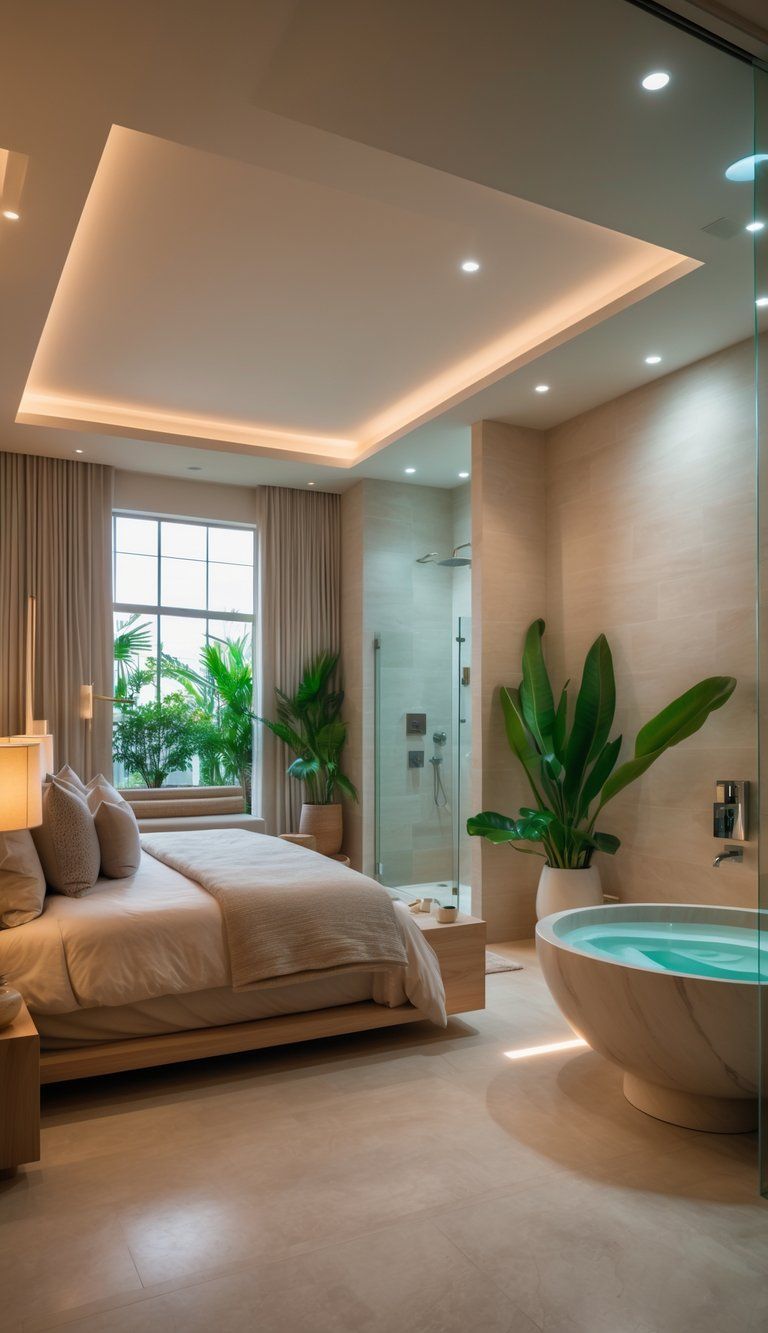
Turn your bathroom into a peaceful escape from daily stress. A spa-like bathroom blends comfort and luxury, giving you a personal sanctuary right next to your bedroom.
Soaking Tubs and Luxurious Fixtures
A freestanding soaking tub can easily become the star of any spa-inspired bathroom. I’d go for a deep tub that lets you sink in completely—nothing beats that for real relaxation.
Stone, copper, or acrylic tubs don’t just look good; they feel great too. Each material brings its own vibe and comfort.
If you want a luxurious feel, swap out your old fixtures for something special. Maybe try:
- Rainfall showerheads that make every shower feel like gentle rain
- Massage jets for those sore muscles
- Heated floors that keep your toes happy all year
- Dimmer switches so you can set the mood just right
I love how hidden lighting under vanities or behind mirrors creates a soft glow. It really boosts the calming atmosphere in the room.
Natural stone countertops—think marble or granite—add elegance and stand up to daily use.
You don’t need a full remodel to get that spa feeling. Toss in some plush towels, a couple of wooden bath trays, or a leafy plant, and you’re halfway there.
Seamlessly Connecting Bedroom and Bath
When you connect your bedroom and bathroom, the whole master suite just feels more inviting. Instead of a solid door, try a partial wall or a frosted glass divider. You’ll keep some privacy but the spaces won’t feel cut off from each other.
Matching colors and materials in both rooms can tie everything together. Soft neutrals like cream, pale blue, or sage green? They’re basically made for spa vibes.
Here are a few ways to keep that connection going:
- Use the same flooring or at least something that complements
- Pick lighting that feels consistent in both spaces
- Repeat design touches, like wood or metal finishes, so nothing feels out of place
A little transitional area between the rooms works great as a dressing spot or a vanity nook. This buffer makes both spaces feel like they belong together.
If you’re into smart tech, you can set up controls for lighting, temperature, and even your bath—without leaving your bed. Pretty convenient, honestly.
Optimizing for Improved Sleep and Relaxation
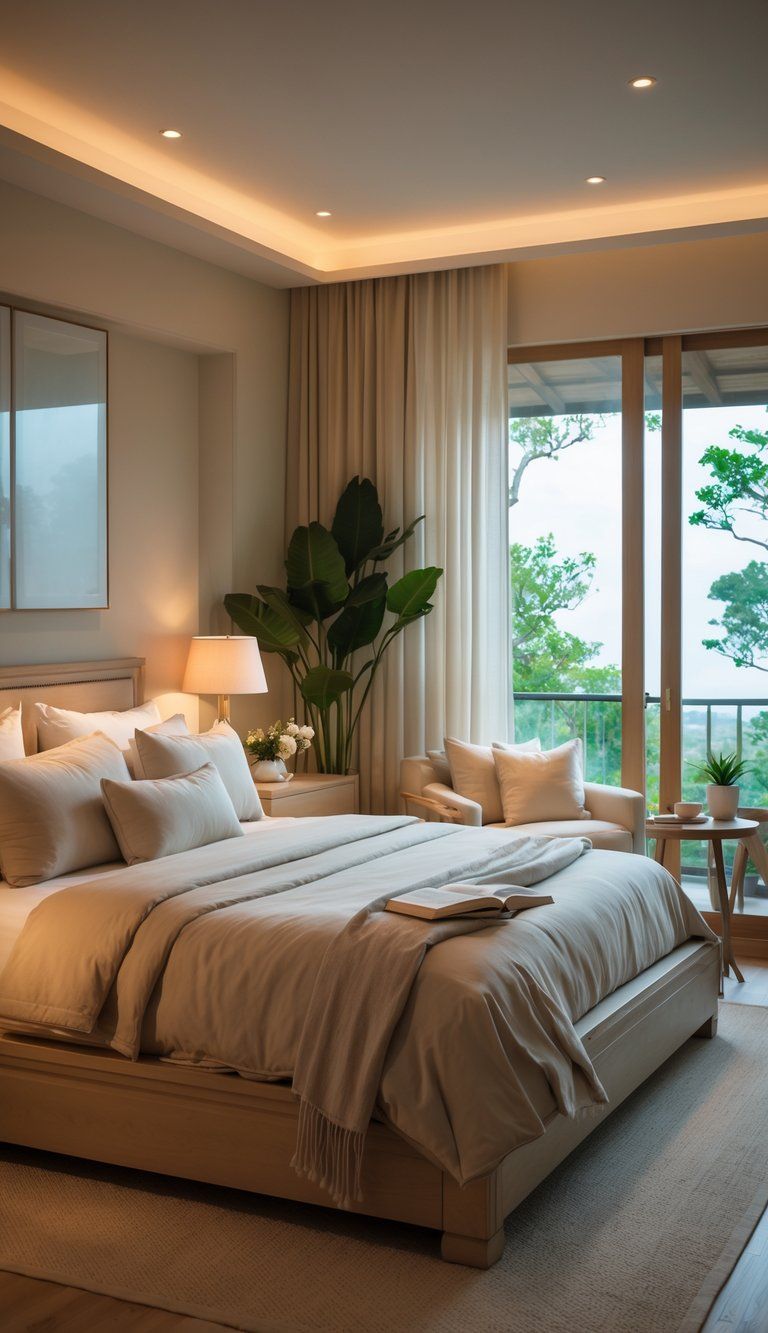
If you want better sleep, focus on controlling light and sound in your bedroom. The right setup can make a huge difference for your sleep and just how you feel overall.
Blackout Curtains and Window Treatments
Blocking out light is key for quality rest. Blackout curtains stop unwanted light from messing with your sleep cycle. I’d look for ones with thermal properties—they help keep the room at a comfy temperature too.
Layering window treatments gives you options. Sheer curtains let in daylight but keep things private. Blackout curtains or blinds make it dark when you need to crash.
Want a little luxury? Motorized blinds mean you can control the light without getting up. Set them to open slowly in the morning for a gentle wake-up—honestly, it’s a game changer.
Pro tip: Curtains in calming shades like soft blue, green, or simple neutrals make the whole room feel more peaceful.
Ensuring a Quiet, Restful Environment
Noise sneaks in and steals sleep more often than you’d think. Try laying down area rugs, adding some cozy upholstered chairs, or even hanging textured wall coverings—these soak up sound and keep things peaceful.
White noise machines can really help. They fill the room with steady, gentle sounds that make other noises fade into the background. A lot of folks swear by these for a more comfortable bedroom vibe.
You might want to try a few of these ideas:
- Add weather stripping around doors and windows.
- Put up acoustic panels (they come in fun designs now).
- Use soft, thick bedding that can muffle sound.
- Line bookshelves along shared walls.
Sound machines come with all sorts of options, like rainfall or ocean waves. Honestly, some smart devices already have sleep-sound settings built in—why not use them to help you relax?
If you’re aiming for deep rest, push your electronics away from the bed, at least 3 feet. The blue light and those endless notifications? They can really mess with your sleep.

